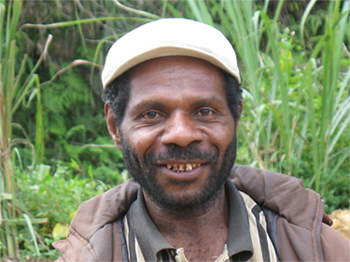
Daniel Wemp smiles at photographer and imediaethics researcher Michael Kigl, in the Southern Highlands of Papua New Guinea, July 2008. Kigl quickly located Wemp, even though New Yorker fact checkers failed to do so. Wemp adamantly denies Diamond's quotations that convey most of the facts in the New Yorker tale were ever said by him. Dr. Douglas Biber's conclusion that the words Diamond quoted were in all likelihood academic writing and not speech, supports Wemp's claim with science.
To indicate just how different the Diamond quotes are from the language of normal conversation, we can compare the rates of occurrence for these specialized grammatical features. All rates are computed for the same basis: a rate per 1-million words of text. For actual conversation, the rates are computed from analysis of a 5-million word corpus (with most specific findings taken from the Longman Grammar of Spoken and Written English; LGSWE). The rates for the Diamond quotes are based on the approximately 1,500 words of quotes in the New Yorker article. The following table compares the rates of occurrence for several of the features discussed in Section 2 above.
| Grammatical feature | Rate in actual conversation | Rate in Diamond quotes | Comparison of the two |
| Attributive adjectives (e.g., original, biological) | c. 15,000 | c. 30,000 | 2 times more frequent in Diamond quotes |
| Preposition of | c. 12,000 | c. 34,000 | 3 times more frequent in Diamond quotes |
| Noun post-modifier complexes (e.g., The original cause [of the wars [between the Handa and Ombal clans] ]) | c. 500 | c. 3,000 | 6 times more frequent in Diamond quotes |
| Noun phrases with both pre-modifiers and post-modifiers (e.g., a stone quarry from which the Ombal enemy was throwing stones) | c. 500 | c. 4,000 | 8 times more frequent in Diamond quotes |
| ‘extraposed’ to-clauses controlled by an adjective (e.g., it’s not acceptable [to set fire to the hut]) | c. 100 | c. 2,000 | 20 times more frequent in Diamond quotes |
| Noun + to-clause (e.g., the opportunity [to see who really are the best marksmen]) | c. 50 | c. 1,200 | 25 times more frequent in Diamond quotes |
| Adjective and/but adjective (e.g., tall and handsome) | c. 20 | c. 2,000 | 100 times more frequent in Diamond quotes |
| Preposition + Relative pronoun (e.g., each battle in which we succeeded in killing an Ombal) | c. 20 | c. 2,000 | 100 times more frequent in Diamond quotes |
These comparisons show the magnitude of the discrepancies between the grammatical style of normal conversation contrasted with the grammatical style of the Diamond quotes. To find one of these grammatical features in a normal conversation is noteworthy. To find repeated use of this large constellation of features in actual spoken discourse, some of them occurring c. 100 times more often than in normal conversation, is extremely unlikely. In contrast, these are all features that are typical of academic writing, suggesting that they have their origin in writing rather than actual speech.
Other corpus studies (e.g., the book University Language; Biber, 2006) have shown that these same features are rare and exceptional in even academic speech, including university lectures. In contrast, what we find in the Diamond quotes is the pervasive use of a suite of grammatical constructions, which are all rare in conversation but common in formal writing. This constellation of grammatical characteristics is also strikingly different from the grammatical style of the verbatim transcripts of speech produced by DW. In sum, the analysis strongly indicates that the Diamond quotes are much more like discourse that was produced in writing, reflecting the typical grammatical features of formal academic prose, rather than verbatim representations of language that was produced in speech.
Douglas Edward Biber, Regents’ Professor, Applied Linguistics, Northern Arizona University. Research interests: English grammar, sociolinguistics, computational and statistical tools for linguistics, corpus linguistics, and register variation (synchronic, diachronic, cross-linguistic). Educational and Professional Experience; External Grants Funded; Books and Mongraphs; Academic Articles






